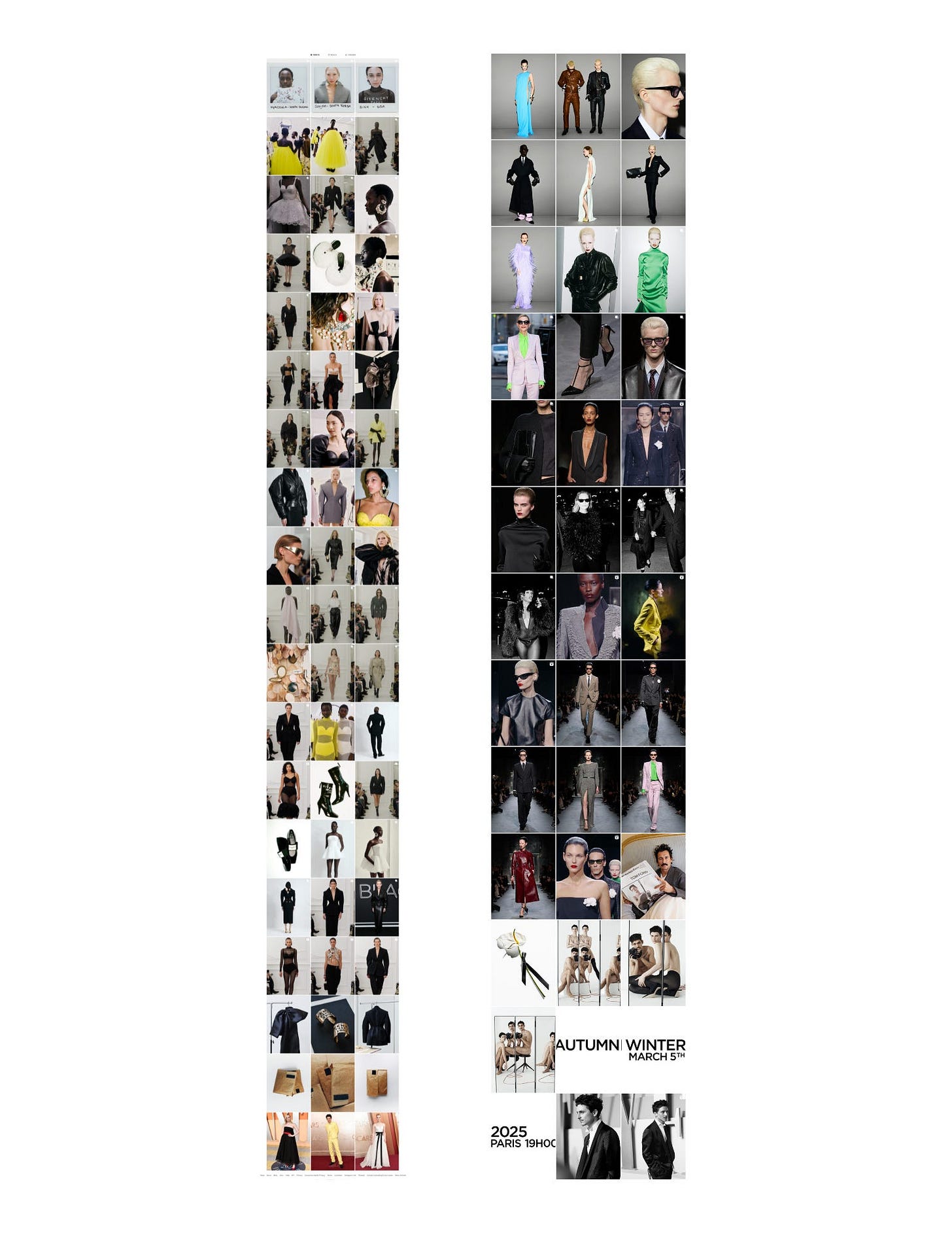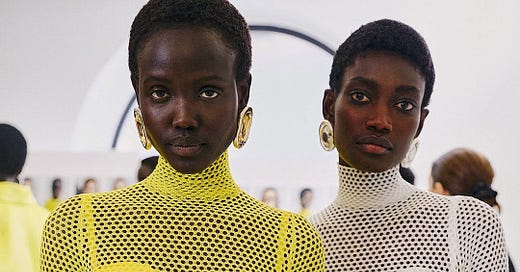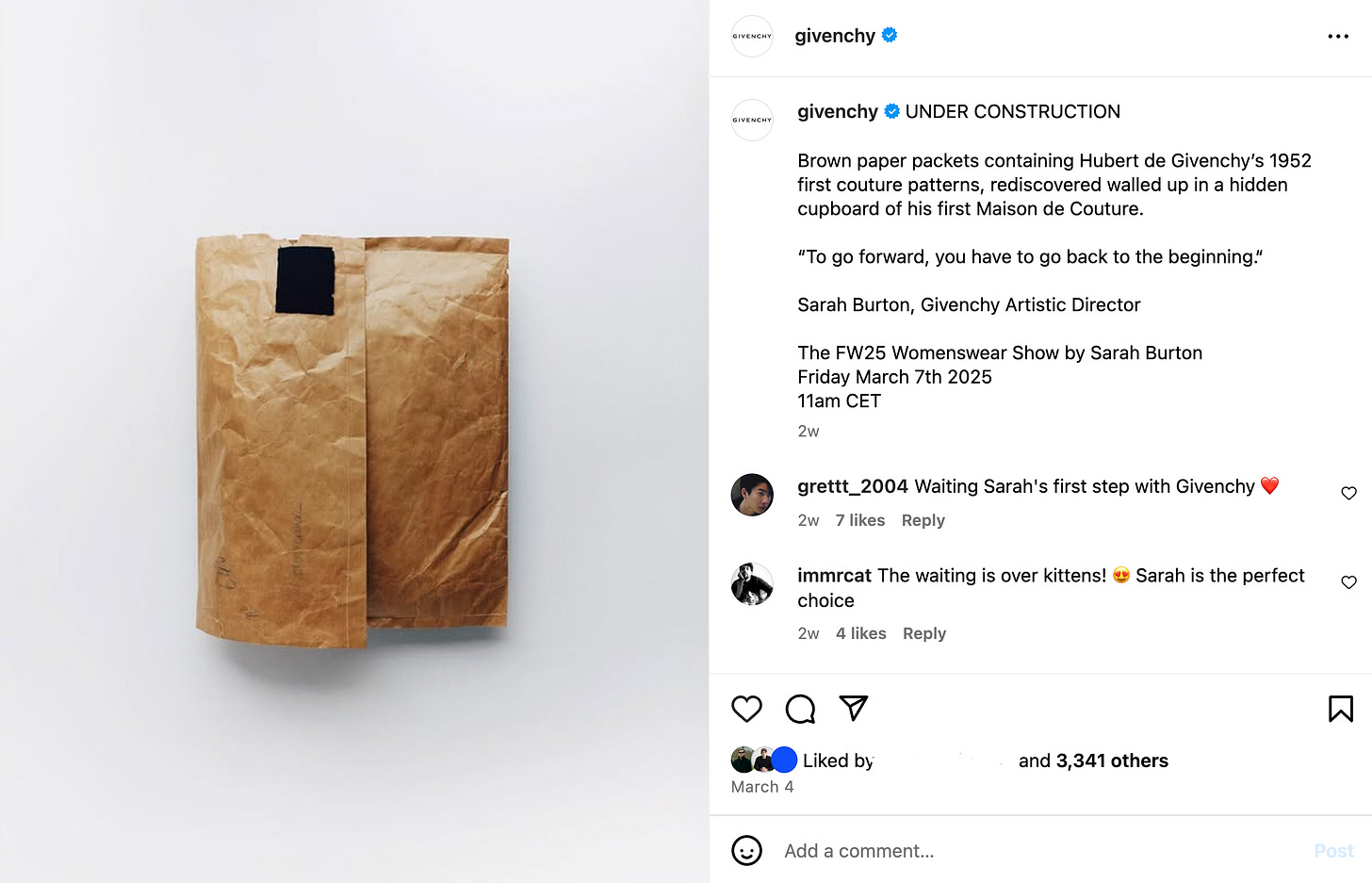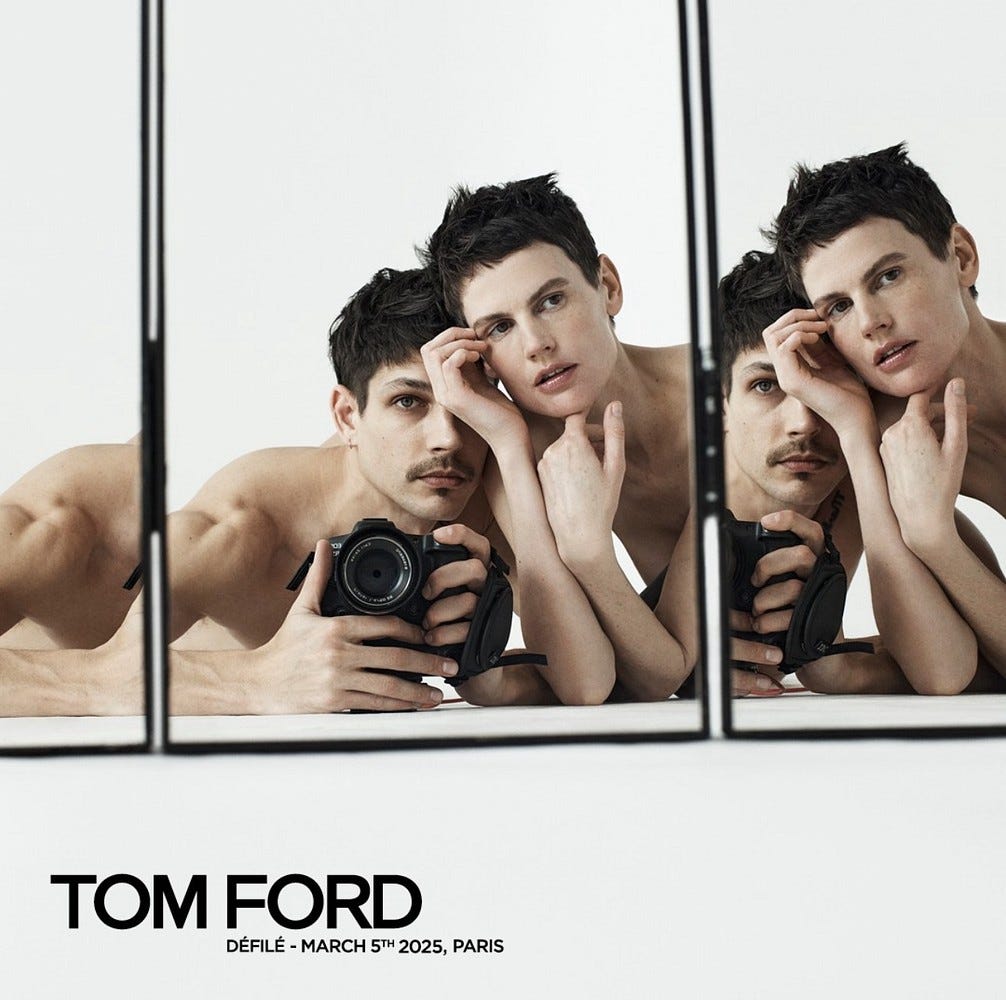Dispatch Nº8: The Shock Of The New. The Timidity Of The Old
Why runway shows need to turn into interconnected marketing narratives for brands.
I am really excited to share my guest post from yesterday’s The Sociology of Business. This one has been a long time coming.
The wait was over.
The editors, buyers, VIPs, and all the rest were cramped into small spaces, ready to render their judgment on this cavalcade of new. New designers, new ideas, new spaces, new conversations.
Newness breeds anticipation. It stokes possibility. As each model sauntered down narrow catwalks, new ideas on classic, or near classic motifs, appeared. New ideas, new conversations.
The only thing that wasn't new? The marketing around the shows.
A healthy distance from the Fashion Week (with a trade war thrown in for good measure) allows the hot takes to settle and critical thinking to flourish. And the further away from the Paris Fashion Week, the more stark the missed opportunity appears for two brands with significant debut moments. Givenchy and Tom Ford demonstrated the relative perils of that disconnect, where the shock of the new (the clothes) meets the timidity of the old (how the clothes and the brand were communicated).
So near, yet so far…
Shows operate on multiple levels, such as stylistic statements, commercial statements, brand builders (both of brand and attendees), storytellers, and flexes of craft. In this multi-layered brand world, these dynamics at their best all interconnect. The different constituents are satiated.
The Givenchy, Tom Ford, and Dries Van Noten shows are successes within some of those levels. They are resets and reinterpretations of well-established brand codes delivered with difficulty, care, and attention.
Yet on marketing and brand-building levels, both Givenchy and Tom Ford stumbled in (re)building brand equity, leaving much of the beginning of their new story unfulfilled. A traditional sense of letting the work speak for itself, but missing the value of what happens when the entire brand world adds breadth and depth to deliver its core creative message.
Prisoners Of A Played-Out Playbook
To see where it missed, you have to go back. The timing of the Oscars for both brands was perfect. High visibility for debut ‘tease’ moments. The building blocks for the shows for both brands, with Timothee Chalamet in particular pulling double duty.
Yet the moments came and went, a vacuum, a tease with no follow-through. Neither Chalamet nor Elle Fanning (dressed exclusively in Givenchy) connected to the broader brand story.
No matter though, as both Sarah Burton and Haider Ackermann were out on the PR circuit, shaping their personal narratives and relationships to both brands.
Burton explained that the last six years of the brand had been "a long period of soul searching, with only limited clarity."
Limited clarity hung in the air like a tantalizing prospect. Who is it for? What does this brand say? And mean? Limited clarity had stopped the momentum of many a Givenchy designer before. Limited clarity saw Tom Ford’s successor last a year.
Opportunity on this occasion manifested in a rather fortuitous discovery for Givenchy.
“During a renovation of that hôtel particulier, a stash of trash bags containing archival patterns from Givenchy's first collection were discovered inside a wall — "like a gift. I haven't used them and made them again; I think you have to go back, but you also have to go forward. But I love the idea that they exist; they're kind of a magical thing,"
A magical thing indeed. A brand identified as lacking clarity around its design language had stumbled upon what amounted to the source text as a metaphor and jumping-off point for resetting the fashion and the brand at large. A source code of brand world thinking.
How did that gift of brand origin manifest to the 16M Givenchy followers on Instagram?
Like this:
Three sequential posts picturing the paper bags and the original artifacts. Not an idea that dramatises this moment of discovery, nor finds a creative way to connect to the past. Not more details on what was in those bags, nor a desire to tease an audience to drive viewership and attention. Sure, those Brown paper bags translated into show notes, guides, and seating. But only for the attendees. For those on the outside looking in, those not part of 0.001875% total fan base who could attend, these stories, these teasers, were left unfulfilled.
To pardon the pun. Givenchy fumbled the bag.
Over at Tom Ford, a similar form and flow emerged.
The PR machine answered existential questions about how Ackermann would differ from his (very much alive) namesake. How would he grapple with the 'ghost in the machine'? How would this Tom Ford relate to Tom Ford in beauty and fragrance? What were the threads connecting the runway to the rest of the brand?
A triptych of Saskia Brenuew and Ethan James Green contoured into each other, providing wispy, obtuse answers. A Factory / Mapplethorpe-esque lens on the brand's future, looking back on itself? Tom Ford, the morning after the decadence of the night before?
It was chic, it was different, but was it enough?
So, just like Givenchy, Tom Ford rolled out a new idea for clothes and the story.
"Guests milled around a room lined in low-slung banquettes, with mirrored walls, though not the sort of 1970s disco-mirrors that once characterized Mr. Ford's own shows, but mirrors with their shine just slightly worn off; distressed mirrors. Black-clad waiters carried silver trays heavy with cut crystal lowball glasses… It felt like a private club without a name. The kind of place that if you knew, you knew. Though you didn't quite know what would happen next."
However, Ackermann's show notes detailed the potential overlooked in bringing his brand world idea to life.
"He [Tom Ford] is nightlife, I am the morning after; this is where our dance begins,"
While both shows were well reviewed, Ackermann’s challenge is more complex, combining two divergent worlds (beauty/fragrance & RTW). Their lack of deeper context prevented the show from engaging a lapsed fandom or growing its audience. In a brand world, the show, absolutely elemental to the concept of a fashion and luxury brand, was poorly served by this lack of brand building around the world that the show was meant to reveal.
As the brands rolled out their post-show content, it followed these expected patterns. Celebrity attendees, show content, clothing details, and the fully covered show's demonstration of the brand vision felt truncated. Missing the inputs of why to help fully realize the outputs of how. Interestingly, since the show, Givenchy has effectively stopped posting. Further demonstrating this isolation from the rest of the brand world that’s supposed to be built.

From linear to interconnected stories
Before the Paris shows started, BoF posited that the 'dream machine' had to crank into overdrive to address this malaise, and that wasn't simply about throwing money at the problem.
"Brands are seeking a refreshed product offer and marketing message to cut through a saturated landscape, particularly on social media, at a difficult time for the sector. For some houses, balancing ever-greater global visibility with cultural relevance and an aura of preciousness and exclusivity has become increasingly difficult."
In that same ADD ecosystem, this is where the power of brand world thinking has become more and more timely. As Ana herself has identified.
"It's not enough to market a movie; you need to market a point of view and a taste filter that a studio provides. It's not enough to launch a collaboration; you have to also open a cafe to celebrate it, or host a private listening party."
So why has the storytelling around shows stayed so rigid and orthodox?
One culprit is the shows themselves, as they've become more significant, as have their cost and complexity. They are designed for social content and consumption by attendees, and they are a one-shot-only event. Naturally, this increases the desire to go with the ‘tried and true’ way of presenting the show.
The downstream effect? The show sets have sometimes become more significant than the story of the clothes and the brand itself. While the aesthetic spectacle is essential, it doesn't only help move the story along the flywheel.
There's always been a debate about who a show is for, and that debate obscures a bigger reality. It will likely be one of the most significant investments of the year. The playbook of contextualizing and communicating a show has become its prison.
Out of the top 10 shows based on "dominating social media," brands that leaned into celebrity or a show gimmick stood out. Neither Givenchy nor Tom Ford was featured, yet both were highly anticipated.
But the tactics had no strategy behind them. To launch their vision, the clothes needed the story to back them up, not just in journalist notebooks or armchair TikTokkers but in how the brand communicated that message and shaped the story.
They needed a flywheel approach.
From Channel Strategies to Concept-Driven Flywheels
A flywheel approach puts the show at the brand's heart, and then seeks to investigate, interrogate, entertain, and luxuriate in it from all possible angles. It’s AUGMENTING what’s already being created, by weaving them into the larger story the designer and the brand are saying. Creating many ways to add to the show's story without overshadowing the point of the show itself.
The clothes and the craft
Many brands understood the assignment. Applying a flywheel-esque methodology to their show content with strong results.
Miu Miu, with its cinematic out-of-the-box film from Hailey Benton Gates or even turning its show invites into objects of desire, is constantly playing with intrigue and heightening tension for the brand before a model has walked. Like a film trailer, it hinted at the possibility, dialed up tension, and placed you in the middle of a story.
LOEWE's ability to build its brand world at this point is a cliche, but it's a cliche for a reason.
For its show content, the brand set up the reason why the show ('the scrapbook') and provided context for one of its most central conceits (the use of Anni & Joseph Albers's work in the space). Weaved in product details with a larger context of inspiration and creation, leveraged the talent it invited in unusual, ordinary ways, and experimented with different content creation ideas within the space. Its trademark humor and devotion to craft are in perfect balance.

Ferrari turned their invite into a fragment of a story. A view from the ‘Officina’, as inspiration from the collection lit up by the headlamps of a (what else) a Testarossa. Hinting at something cinematic arriving from Marenello. Supported by the content itself existing within this world.
Even Louis Vuitton dropped their own 35-minute 'making of' the show documentary this week, demonstrating that the flywheel isn't simply about the tease, it can be a demonstration of the entire narrative. The spectacle and the craft can sit together.
For these brands, every spoke of the flywheel was covered: the who, the what, the where, the why. Threaded through a core narrative idea and story, you could follow along. There were multiple ways into the moment.
Building Out A Flywheel
The flywheel leverages channels at different points and for different objectives; the linear story can work globally and locally and across all elements of the brand’s footprint. It also doesn’t just rely on the designer to carry the burden of the show. The concept allows the designer’s approach to be supported and augmented.
Each channel can also take on a specific role - driving craft, concept, talent and PR moments. Mixing owned and earned moments, but through a more cohesive central idea. It's not about overpowering the show with gimmicks but providing many avenues into it for those not obsessed with it (yet).
So, how should brands approach these moments?
Treat the show story as a bridge into the brand world. As each collection builds on its design language, the same applies to the show; the show has to act as a bridge for those not in the room to connect with the brand. Find opportunities in stories to deliver that connection.
If you have heritage, use it. Defining the core idea then helps create new ways to express it. Equally, if the brand is playing with its heritage, find ways to leverage that beyond simply a history lesson.
Treat each part of the show as a chapter. Approaching with a filmic perspective aims to inject drama and tension into the moments. The show is all about anticipation and intrigue, and the tone of the content before the show should maximize this state.
Subverting existing constructs. Shows have built up an expected and anticipated language - people know what they expect. The opportunity is to twist them. Turn the constructs on their head to keep people engaged and the narrative fresh. (LOEWE’s interviews hosted by Evan Ross Katz),
Shaping the narrative informs talent. The team is free to invite who they want for whatever strategic reason the talent fulfills, but those talents become part of the story, not simply attendees. (Nadia Lee Cohen at Coperni is a good example of this)
Provide variety through the vision. Different audiences respond differently to parts of the story. Therefore, it is critical to cover the narrative, the craft, the details, and the conversation, both in the space and beyond. Everything is entertainment, but skewed to what different audiences, from casual to obsessive, find entertaining. One person's detailing of the construction process is another doorway into the brand's myths or heritage.
Inherently, there will be more moments for both Givenchy and Tom Ford to expand upon their ideas and stories. The beauty of fashion shows is their constant ability to evolve and reset themselves. They are a creative gift.
But that gift demands more than simply capturing the moment and documenting the scene; it requires what a truly creative, holistic brand world can deliver: a bridge into these worlds that continue to beguile and compel, weaving the shows tighter into how the rest of the world experiences and engages with the brand.
For brands of this scale and influence, the opportunity to define the shape and concept of the clothes needs to go hand in hand with the brand's narrative and vision. Together, they delight the faithful and intrigue the casual observer.









This is world class writing and content. Big fan.